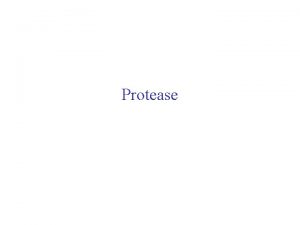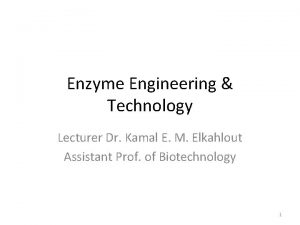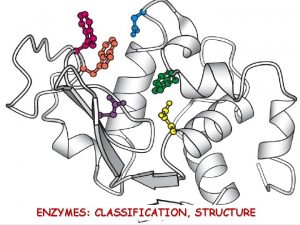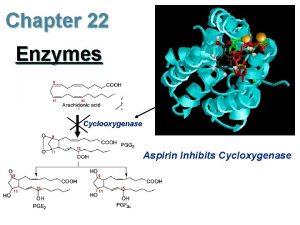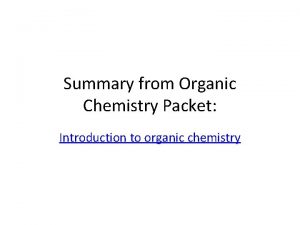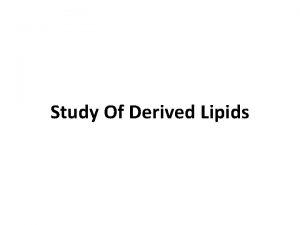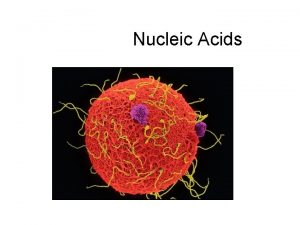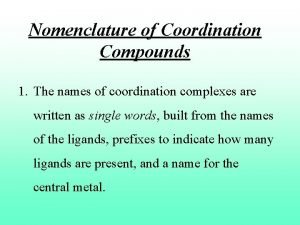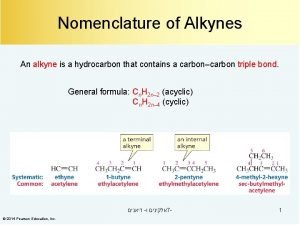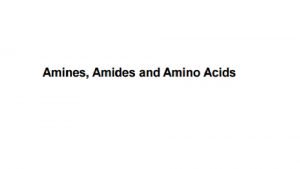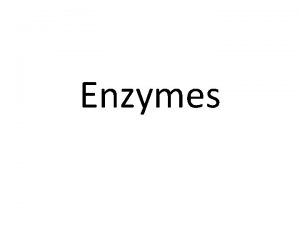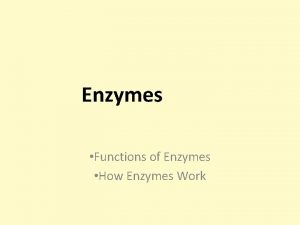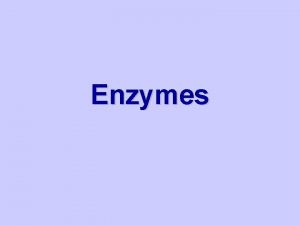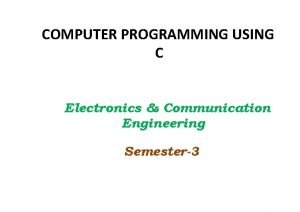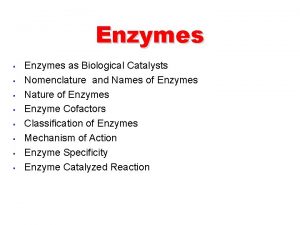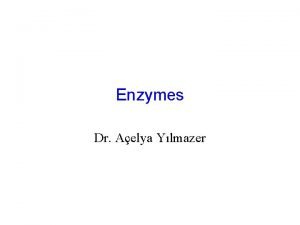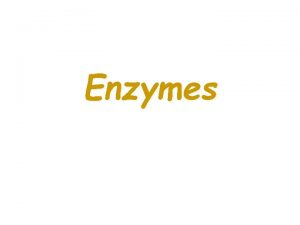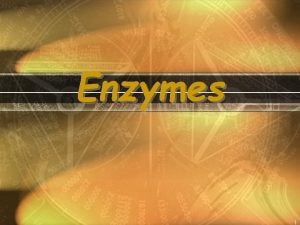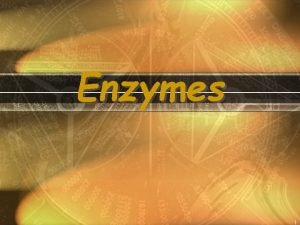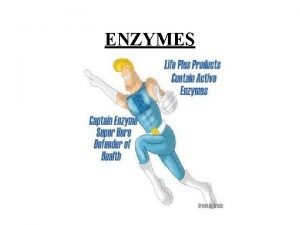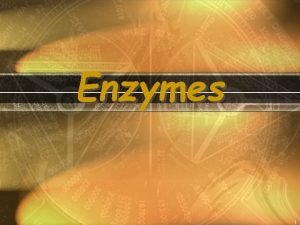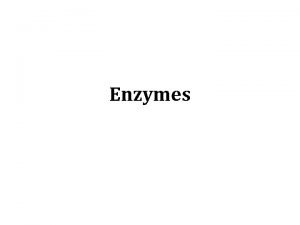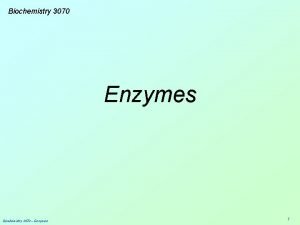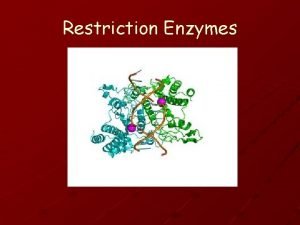NOMENCLATURE CLASSIFICATION OF ENZYMES UG05 Semester3 rd ENZYMES






















- Slides: 22

NOMENCLATURE &CLASSIFICATION OF ENZYMES UG-05 Semester-3 rd

ENZYMES • Biological catalysts which speed up the rate of reaction without becoming part of the reaction but themselves cannot initiate any chemical reaction. • Enzymes : • First name is of substrate • second, ending in “ASE” indicating type of reaction catalyzed. • Clarify the reaction , e. g. Malic Enzyme • L- Malate + NAD Pyruvate + NADH-H + CO 2 • Malate NAD oxidoreductase (Decarboxylating)

Trival name • Gives no idea of source, function or reaction catalyzed by the enzyme. • Example: trypsin, thrombin, pepsin.

Systematic Name • According to the International union Of Biochemistry an enzyme name has two parts: -First part is the name of the substrates for the enzyme. -Second part is the type of reaction catalyzed by the enzyme. This part ends with the suffix “ase”. Example: Lactate dehydrogenase

EC number • Enzymes are classified into six different groups according to the reaction being catalyzed. • The nomenclature was determined by the Enzyme Commission in 1961 (with the latest update having occurred in 1992), hence all enzymes are assigned an “EC” number. • The classification does not take into account amino acid sequence (ie, homology), protein structure, or chemical mechanism.

EC numbers • EC numbers are four digits, for example a. b. c. d, where “a” is the class, “b” is the subclass, “c” is the subsubclass, and “d” is the sub-subclass. The “b” and “c” digits describe the reaction, while the “d” digit is used to distinguish between different enzymes of the same function based on the actual substrate in the reaction. • Example: for Alcohol: NAD+oxidoreductase EC number is 1. 1

CLASSIFICATION OF ENZYMES Formulated by the enzyme commission of I. U. B six major classes based on the type of reactions catalyzed 1. Oxidoreductases • Catalyzing oxidation reduction reactions 2. Transferases • Catalyzing group transfer 3. Hydrolases • Catalyzing hydrolytic breakdown

Classification of Enzymes 4. Lyases • Catalysing removal of groups by mechanism other than hydrolysis and leaving behind double bonds 5. Isomerases • Catalysing interconversion of isomers 6. Ligases • Catalysing formation of bonds and new compounds 1. Oxidoreductases – Catalysing oxidation reduction reaction where one substrate is oxidized and other is reduced

CLASSIFICATION OF ENZYMES Oxidases. Catalyzing oxidation of the substrate and atomic oxygen acts as recipient of hydrogen e. g. Ascorbic acid oxidase, Cytochrome oxidase, Tyrosinase Ascorbic acid Oxidase Ascorbic acid + O 2 Dehydro ascorbic acid

CLASSIFICATION OF ENZYMES Aerobic Dehydrogenases. Catalyzing oxidation of the substrate and molecular oxygen acts as recipients of hydrogen e. g. Glucose oxidase, L amino acid dehydrogenase, Xanthene dehydrogenase glucose oxidase Gluconolactone

CLASSIFICATION OF ENZYMES Anaerobic Dehydrogenases. Catalyzing oxidation of the substrate and coenzymes act as recipients of hydrogen e. g. Lactate Dehydrogenase with NAD and Glucose 6 phosphate dehydrogenase with NADP Lactate dehydrogenase Lactic acid + NAD Pyruvic acid + NADH – H+

CLASSIFICATION OF ENZYMES Oxygenases: Is an enzyme that oxidizes a substrate by transferring the oxygen from molecular oxygen O 2 (as in air) to it. Types : a. Monooxygenases: Transfer one oxygen atom to the substrate, and reduce the other oxygen atom to water. b. Dioxygenases: Incorporate both atoms of molecular oxygen (O 2) into the product(s) of the reaction. Among the most important monooxygenases are the cytochrome P 450 oxidases, responsible for breaking down numerous chemicals in the body.

2. TRANSFERASES Transaminases. Catalyzing transfer of amino group between an amino acid and a ketoacid e. g. Aspartate transaminase (AST), Alanine transaminase (ALT) Aspartate transaminase (AST) Glutamic acid + Oxalo acetic acid Alanine transaminase (ALT) Glutamic acid + Pyruvic acid ketoglutaric acid + Aspartic acid ketoglutaric acid + Alanine

2. TRANSFERASES Transmethylases. Catalyzing transfer of methyl group between to substrates e. g. COMT Noradrenalin + CH 3 Catechol-Omethyltransferase (COMT) Adrenaline Transpeptidases. Catalyzing transfer of amino acids to substrates e. g. Benzyl-SCo. A transpeptidase Benzyl - SCo. A + Glycine Hippuric acid

2. TRANSFERASES Phosphotransferases. Catalyzing transfer of phosphate group to substrates e. g. Hexokinase, glucokinase 2. 7. 1. 1 ATP D hexose 6 phosphotransferase [Hexokinase] ATP + Glucose Hexokinase ADP + D-Glucose – 6 -P Acetyltransferase. Catalyzing transfer of acetyl group to substrates e. g. choline acetyltransferase Acetyl-Co. A+ Choline Co. A + Acetyl- Choline

3. HYDROLASES Catalysing hydrolytic breakdown of different bonds. Most of the GIT enzymes belong to this class Enzymes hydrolyzing carbohydrates 1. Polysaccharidases Starch Amylase Maltose, maltotrios, dextrins 2. Oligosaccharidases Dextrins Dextrinase glucose 3. Disacharidases Maltose, Lactose, Sucrose Disacharidases Maltase, Lactase, Sucrase monosaccharides Enzymes Hydrolyzing Lipids Triacyl glycerol lipase monoacyl glycerol + 2 F. F. A Cholesterol ester cholesterol free cholesterol + FFA esterase

3. HYDROLASES Phospholipids Phospholipase lysophospholipids Lecithin Lysolecithin Enzymes Acting on Peptide Bonds: exopeptidases carboxypeptidase amino acids endopeptidase aminopeptidases e. g pepsin (smaller peptides)

3. HYDROLASES Tripeptidase : Tripeptide A. A Dipeptidase : Dipeptide A. A Phosphatases 1. Phosphomonoesterases: Glucose – 6. P. + H 2 O Phosphatase G 6. Phosphate Glucose +Pi 2. Phosphodiesterases: Removal of phosphate Group of diesters breakdown of 3’-5’ p linkages in cyclic AMP

4. LYASES • Catalysing reactions in which groups are removed without hydrolysis leaving a double bond or add groups to already existing double bonds. CH 3. COOH CH 3. CHO+ CO 2 (pyruvate) pyruvate decarboxylase (acetaldehyde) COOH. CH = CH. COOH Fumerase COOH-CHOH. CH 2 -COOH (Fumaric acid) (malic acid)

5. ISOMERASES • Involved in inter conversion of pair of isomeric compounds • Glucose 6. P Phosphogluco mutase • Glucose 6. P Phosphohexose isomerase Fructose 6. P • All trans retinene glucose I. P Retinene 11 - CIS retinene Isomerase

6. LIGASES • Catalyze reactions in which linking together of two molecules occur coupled with the breakdown of a high energy phosphate bonds like ATP, GTP Acetate + Co. A +ATP Acetyl Co. A+AMP Synthetase Succinate + Co. A + ATP Succinyl Co. A + ADP+ Pi Synthetase Pyruvate + CO 2 + ATP Pyruvate Carboxylase Oxaloacetate + ADP + Pi Fatty acid + Co. A + ATP Acyl Co. A (Activated fatty acid) + AMP + Pi. Pi Synthetase

EC • Every enzyme code consists of the letters "EC" followed by four numbers separated by periods. Those numbers represent a progressively finer classification of the enzyme. • For example, the tripeptide aminopeptidases have the code "EC 3. 4. 11. 4", whose components indicate the following groups of enzymes: • EC 3 enzymes are hydrolases (enzymes that use water to break up some other molecule) • EC 3. 4 are hydrolases that act on peptide bonds • EC 3. 4. 11 are those hydrolases that cleave off the aminoterminal amino acid from a polypeptide • EC 3. 4. 11. 4 are those that cleave off the amino-terminal end from a tripeptide
 Apoenzyme vs holoenzyme
Apoenzyme vs holoenzyme Nomenclature of enzymes
Nomenclature of enzymes Classification of coenzymes
Classification of coenzymes Enzyme classification
Enzyme classification Classification of enzymes
Classification of enzymes Taser 7 nomenclature
Taser 7 nomenclature Nomenclature of bolts
Nomenclature of bolts Oblique cutting
Oblique cutting Basic organic nomenclature packet
Basic organic nomenclature packet Unsaturated fat chain
Unsaturated fat chain Spring nomenclature
Spring nomenclature Skl army tm
Skl army tm E rigging supply
E rigging supply 870 p
870 p Naming of organic compounds
Naming of organic compounds Nucleotide nomenclature
Nucleotide nomenclature Pentose sugar in rna
Pentose sugar in rna Coordination compound nomenclature
Coordination compound nomenclature Naming alkynes
Naming alkynes Thioether
Thioether Prinary amine
Prinary amine End mill nomenclature
End mill nomenclature Milling cutter nomenclature
Milling cutter nomenclature
